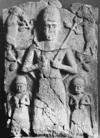- Tammuz
-
/tah"mooz/; for 1 also /tah moohz"/; for 2 also /tam"uz/, n.2. a Sumerian and Babylonian shepherd god, originally king of Erech, confined forever in the afterworld as a substitute for his consort Inanna or Ishtar.[ < Heb tammuz]
* * *
Mesopotamian god of fertility.He was the son of Enki, god of water, and Duttur, a personification of the ewe. Worship of Tammuz was centered around two yearly festivals, one in the early spring in which his marriage to the goddess Inanna symbolized the fertilization of nature for the coming year, and one in summer when his death at the hands of demons was lamented. He is thought to be the precursor of several later deities associated with agriculture and fertility, including Ninsun, Damu, and Dumuzi-Abzu. Tammuz, alabaster relief from Ashur, c. 1500 BC; in the Staatliche Museen zu Berlin, ...Foto MarburgArt Resource/EB Inc.
Tammuz, alabaster relief from Ashur, c. 1500 BC; in the Staatliche Museen zu Berlin, ...Foto MarburgArt Resource/EB Inc.* * *
▪ Mesopotamian godin Mesopotamian religion, god of fertility embodying the powers for new life in nature in the spring. The name Tammuz seems to have been derived from the Akkadian form Tammuzi, based on early Sumerian Damu-zid, The Flawless Young. The later standard Sumerian form, Dumu-zid, in turn became Dumuzi in Akkadian. The earliest known mention of Tammuz is in texts dating to the early part of the Early Dynastic III period (c. 2600–c. 2334 BC), but his cult probably was much older. Although the cult is attested for most of the major cities of Sumer in the 3rd and 2nd millennia BC, it centred in the cities around the central steppe area (the edin), for example, at Bad-tibira (modern Madīnah) where Tammuz was the city god.As shown by his most common epithet Sipad (Shepherd), Tammuz was essentially a pastoral deity. His father Enki (Ea) is rarely mentioned, and his mother, the goddess Duttur, was a personification of the ewe. His own name, Dumu-zid, and two variant designations for him, Ama-ga (Mother Milk) and U-lu-lu (Multiplier of Pasture), suggest that he actually was the power for everything that a shepherd might wish for: grass to come up in the desert, healthy lambs to be born, and milk to be plentiful in the mother animals.When the cult of Tammuz spread to Assyria in the 2nd and 1st millennia BC, the character of the god seems to have changed from that of a pastoral to that of an agricultural deity. The texts suggest that, in Assyria (and later among the Sabaeans (Sabaean)), Tammuz was basically viewed as the power in the grain, dying when the grain was milled.The cult of Tammuz centred around two yearly festivals, one celebrating his marriage to the goddess Inanna (Ishtar), the other lamenting his death at the hands of demons from the netherworld. During the 3rd Dynasty of Ur (c. 2112–c. 2004 BC) in the city of Umma (modern Tell Jokha), the marriage of the god was dramatically celebrated in February–March, Umma's Month of the Festival of Tammuz. During the Isin–Larsa period (c. 2004–c. 1792 BC), the texts relate that in the marriage rite the king actually took on the identity of the god and thus, by consummating the marriage with a priestess incarnating the goddess, magically fertilized and fecundated all of nature for the year.The celebrations in March–April that marked the death of the god also seem to have been dramatically performed. Many of the laments for the occasion have as a setting a procession out into the desert to the fold of the slain god. In Assyria, however, in the 7th century BC, the ritual took place in June–July. In the major cities of the realm, a couch was set up for the god upon which he lay in state. His body appears to have been symbolized by an assemblage of vegetable matter, honey, and a variety of other foods.Among the texts dealing with the god is “Dumuzi's Dream,” a myth telling how Tammuz had a dream presaging his death and how the dream came true in spite of all his efforts to escape. A closely similar tale forms the second half of the Sumerian myth “The Descent of Inanna,” in which Inanna (Akkadian: Ishtar) sends Tammuz as her substitute to the netherworld. His sister, Geshtinanna, eventually finds him, and the myth ends with Inanna decreeing that Tammuz and his sister may alternate in the netherworld, each spending half of the year among the living.Tammuz's courtship and wedding were a popular theme for love songs and anecdotal verse compositions that seem to have been used primarily for entertainment. A number of true cult texts, however, follow the rite step by step as if told by a close observer, and many laments were probably performed in the actual rites.Eventually a variety of originally independent fertility gods seem to have become identified with Tammuz. Tammuz of the cattle herders, whose main distinction from Tammuz the Shepherd was that his mother was the goddess Ninsun, Lady Wild Cow, and that he himself was imagined as a cattle herder, may have been an original aspect of the god. The agricultural form of Tammuz in the north, where he was identified with the grain, may also have been an originally independent development of the god from his role as the power in the vegetation of spring. A clear fusion, though very early, was the merger of Tammuz in Uruk with Amaushumgalana, the One Great Source of the Date Clusters; i.e., the power of fertility in the date palm (see Dumuzi-Amaushumgalana).A later important fusion was the merger of Tammuz and Damu, a fertility god who probably represented the power in the sap of rising in trees and plants in spring. The relation of still other figures to Tammuz, such as Dumuzi-Apzu (Dumuzi-Abzu)—a goddess who appears to have been the power in the waters underground (the Apzu) to bring new life to vegetation—is not entirely clear.* * *
Universalium. 2010.
